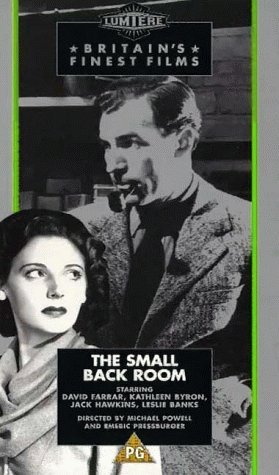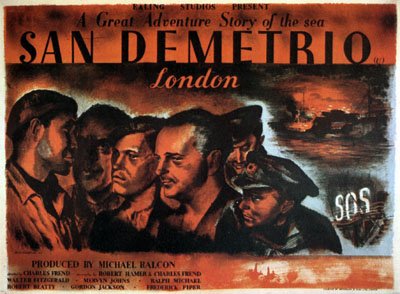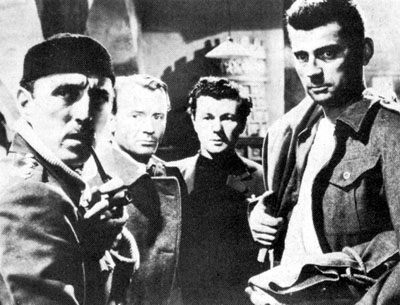|
The Small Back Room (1948)
Cut to ribbons by its original American distributor, this 1949 film remains the most elusive of Michael Powell's mature works. David Farrar stars as a crippled, alcoholic bomb expert who tries to solve the secret of a new Nazi device: small bombs made to look like toys that explode when children pick them up. With Kathleen Byron, who gives a quite magical performance, Jack Hawkins, Anthony Bushell, and Michael Gough.
|
 |
A Matter of Life and Death (1945)
also known as Stairway to Heaven
Produced by the inventive team known as The Archers: Michael Powell and Emeric Pressburger. A Matter of Life and Death, also known as Stairway to Heaven is the remarkable British fantasy film that became the surprise hit of 1946. The superbly crafted story is a tale of the power of love against "the powers that be". However, its deception lies in the complexity of its "is it real or is it imaginary?" premise.
Squadron Leader Peter D. Carter (David Niven) is a World War II RAF pilot returning from a bombing raid over Germany who is forced to bail out of his crippled plane without a parachute over the English Channel. While deciding his fate aboard his crippled plane Niven conveys his tale of woe to an American W.A.C. called June (Kim Hunter), before finally leaping from his plane to certain death. He wakes up to find he has landed on Earth utterly unharmed... which wasn't supposed to happen according to the rules of Heaven. While making his way from the beach towards civilisation Niven meets the voice from his final radio transmission - June, and love enters the equation. Niven is visited by Conductor 71 (Marius Goring), a heavenly messenger who informs him he should have died when jumping from his plane. Niven argues that he is now in love due to heavens incompetence and wishes to remain on earth, so a celestial trial is called to decide whether or not to claim Niven's life or to let him survive to wed his American sweetheart (Kim Hunter)
During an operation while surgeons struggle to save his life, Niven dreams that his spirit is on trial, with God (Abraham Sofaer) as judge and Niven's recently deceased best friend Dr Reeves (Roger Livesey) as defence counsel. Dr Reeves sweeps away the anti-British bias of the American prosecutor - and it remains only to prove that Peter and his American sweetheart are genuinely in love. The High Court visits the theatre in which surgeons are operating on Peter, Peter's spirit leaves his body to be cross-examined by the prosecution. Then June is brought into the spirit world to finally win the case for Peter, she cares so much for him that she is willing to sacrifice herself to take his place in the Other World. The film tries to have it both ways by suggesting that the Heavenly scenes are all a product of Niven's imagination, but the audience knows better. Among the curious but effective artistic choices in A Matter of Life or Death was the decision to film the Earthbound scenes in Technicolor and the Heaven sequences in black and white.
The movie was devised to smooth over the strained relations between Britain and the U.S. after World War II, it is disarming in its gentle reminders of the horrors of war - the numerous casualties, both military and civilian, the need to "go on" when faced with death. There is a conspicuous lack of WWII "enemies" in heaven, but the civilians shown are of indeterminate origin. Powell and Pressburger could have been more explicit in their depiction but it wasn't necessary. The movie may not have served its diplomatic purpose as was hoped for, but its originality continues to inspire moviemakers and viewers alike on both sides of the Atlantic.
|
|
San Demetrio London (1943)
Ealing's last film to be presented in 1943 was another war film in which a small group of men face incredible hardship with unquestioning courage, submerging individual and national differences so that the team can win through. It was a true story, the reconstruction of an epic voyage of an oil tanker which, although so badly damaged it is abandoned, is reboarded later by its crew and brought home to port. San Demetrio London was directed by Charles Frend, with Robert Hamer as the associate producer, and they both wrote the screenplay from the official narrative of the original exploit by F. Tennyson Jesse.
After drifting in a lifeboat for three days, several members of the crew decide that their chances are better on their old ship, which is floundering in mid-Atlantic. They succeed in putting the fires out, patching up the engines sufficiently to limp on to their port of destination, Greenock. As they make their way up the Clyde they proudly refuse the offer of a tow. Without realising it, they have made themselves eligible for salvage money, and the last scene shows them in court receiving a shared award of Ł14,000 for their efforts. The judge says: 'It has given me the best working day of my life in listening to the very modest recital of some gallant gentlemen concerning a memorable achievement.'
The earlier common assumption of leadership and superiority that distinguishes the officers from the lower decks in Convoy and Ships with Wingshas been replaced by a democratic consensus - the big decisions of whether to board the tanker or not and whether to attempt to get it back to England are reached collectively. It is almost as if Ealing is saying that the officer class has let Britain down, and that it is amongst them that the spies (The Foreman Went to France), the quislings (Went the Day Well?) and the pompous stuffed shirts (Ships with Wings) can be found.
Balcon regarded San Demetrio London not only as an epic story of endeavour but also as a way of reminding the public of the perils of Merchant Navy service. Petrol was desperately short, yet a black market flourished, enabling some people to evade rationing. It was in this climate that a Philip Zec cartoon in the Daily Mirror, which showed a torpedoed seaman alone on a raft with the caption "The price of petrol has been increased by One Penny - Official", was interpreted by the Cabinet as unpatriotic and nearly caused the papers closure.
Extract © George Perry: Forever Ealing.
|
 |
The Colditz Story (1954)
Outstanding factual World War Two drama about Allied POW's held in Germany's most secure wartime prison. The film portrays life inside the high-security Colditz Castle and the prisoner’s attempts to break out of the supposed 'escape-proof' establishment. John Mills stars as Pat Reid, the great escaper on whose book the film is based.
The film starts as two captured British POW’s arrive at the notorious Colditz Castle, at first they fear for their lives in the belief execution awaits them. They meet other Allied prisoners and realise the castle is being used to round up the most troublesome persistent escapers and hold them all one secure prison.
RIGHT: Lionel Jeffries, John Mills, Bryan Forbes and Christopher Rhodes.
The prisoners initial attempts at freedom are unsuccessful as various nationalities try to escape without discussing their plans with each other, during the ensuing chaos episodes like the two separate tunnels running each other take place making the German guard’s job easier. Colonel Richmond (Eric Portman) steps forward and decides each nationality must elect an escape officer to ensure co-operation between those attempting to escape. Despite their new found co-operation and seemingly good escape plans the Germans continually foil their attempts to breakout, prompting the belief that there is an informer in their midst. The spy is disclosed as a Pole who was indebted to the Gestapo due to their kind treatment of his family, during the following court martial it is decided his sentence is death. Colonel Richmond goes to the Commandant (Frederick Valk) and requests he transfer the exposed Polish soldier before sentence is passed.
On the spur of the moment a plan is hatched for Jimmy Winslow (Bryan Forbes) to escape on the back of a lorry, the attempt is successful and it appears the first prisoner has broken free from Colditz. Sadly, Winslow is recaptured days later and returned to the castle. Pat Reid (John Mills) and McGill (Christopher Rhodes) are next to hatch a plan to escape as two German sentries while the prisoners are holding a Concert. Upon hearing the plan Colonel Richmond tells McGill he should stand down because he is too well known by the guards and would be a risk to the plans success, McGill is unable to cope with Richmond's request and is killed during a suicidal escape attempt. Pat Reid and three others proceed with McGill’s escape plan and successfully break out of the castle – Reid and Winslow later sending a postcard from Switzerland to inform the prisoners of their freedom. Despite being intended as the most secure POW prison, Colditz held the record for the most successful escapes during the war.
|
 |
The Dambusters
Adapted by R. C. Sherriff from Guy Gibson's book Enemy Coast Ahead, The Dam Busters is a docudrama following the conception and implementation of a new British weapon for smashing the German dams in the Ruhr industrial complex during World War II. In 1942, Dr Barnes Wallis (Michael Redgrave) was possessed with a seemingly absurd idea - the creation of a revolutionary bouncing bomb to destroy the Ruhr dams and paralyse Germany’s heartland. This film describes the development of the bouncing bomb, showing Barnes Wallis shooting marbles across a bath tub of water as the idea begins to form, through to devising a particularly simple bombsight and altimeter that had to be developed. The film is a tribute to the genius of Barnes Wallis who fought persistent scepticism and disbelief from Whitehall that such a feat was possible. Major disappointments accompany the initial trials, the casing of the bomb has to be drastically re-designed, and it transpires that the aircraft will need to approach the dam considerably lower and faster than had been predicted.A special Squadron 617 is formed and selected to carry out the attack on the dams harnessing the energy of the rivers Moehne, Eder and Sorbe, led by Wing-Commander Guy Gibson (Richard Todd) who is given responsibility for the sortie and intensive training. The climax of the film, the actual attack on the German dams is rather a disappointment due to some unimpressive special effects.
|
 |
|
|
|
|
Stills, posters and reviews will change from time to time.
|
|
|
|
|
|
|
 |
|
|
|
|